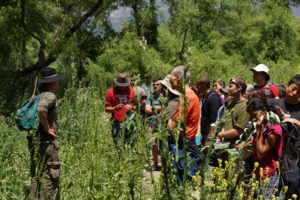It was a crisp Los Angeles morning in Tongavaar (Arroyo Seco) as we gathered for the mushroom hunt, nature walk, and Buddhist meditation. Stragglers showed up, lost in the large Hahamong'na watershed as frisbee golf enthusiasts played through.
First we defined "mushrooms," shared experiences of their many culinary and spiritual uses, then set off on the hunt. A mushroom is the fruiting body of mycelium, the root-like network under our feet that makes forests possible, distributing nutrients and water with a degree of intelligence modern computing networks would envy.
 |
| We did not find the fly agaric (A. muscaria) |
Fire's existence is dependent on conditions
 |
| Fire is unreal in the sense that it is dependent. |
And so it is with a living being. We are composed of the Five Aggregates clung to as self -- form, feeling, perception, formations, and consciousness. (There is no self, no personality, no ego -- in an ultimate sense -- for all things are impersonal).
And so it is with mushrooms. What are the factors for the arising of mushrooms? There has to be food (e.g., cellulose to break down), mycelium, moisture, and so on. Find these, and you'll soon be finding a trove of mushrooms.
 |
| Do not get to get high and call it a good thing. |
The City of Pasadena had laid down truckloads of mulch and woodchips it is no longer allowed to dispose of at the municipal dump, and the recent atmospheric rivers had soaked it. Traveling over bright green stinging nettle, chickweed, horehound, splurge, and grasses, there they were: purple blewits blooming. We examined them by stem, gills, caul, and the all-important base for proper identification. The bright and distinct color gave them away. Soon there were inkcaps, russula, polypores like chicken of the woods and turkey's tail, witches' butter, and LBMs all around us.
What's a good field guide to study?
 |
| Mushrooms Demystified (Arora) |
“Tongva” is not the tribe name
 |
| There are now many tribes in Los Angeles. |
The “Tongva” people didn’t have a name for themselves as a whole, as they were unfamiliar with the concept of having a name to represent their entire people. They identified with their villages rather than as a society as a whole. The generally accepted name was Kizh (pronounced \keech\). Every historical document refers to them as Kizh until this ONE journalist misinterpreted a woman identifying as “Tongavaar,” which was a village [in what is now the Pasadena or Pasadeg'na area].





















































































































































































































































No comments:
Post a Comment